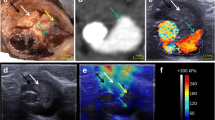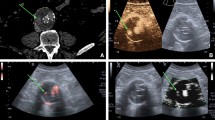Abstract
Purpose
To investigate the feasibility of shear wave sonoelastography (SWS) for endoleak detection and thrombus characterization of abdominal aortic aneurysm (AAA) after endovascular repair (EVAR).
Materials and methods
Participants who underwent EVAR were prospectively recruited between November 2014 and March 2016 and followed until March 2019. Elasticity maps of AAA were computed using SWS and compared to computed tomography angiography (CTA) and color Doppler ultrasound (CDUS). Two readers, blinded to the CTA and CDUS results, reviewed elasticity maps and B-mode images to detect endoleaks. Three or more CTAs per participant were analyzed: pre-EVAR, baseline post-EVAR, and follow-ups. The primary endpoint was endoleak detection. Secondary endpoints included correlation between total thrombus elasticity, proportion of fresh thrombus, and aneurysm growth between baseline and reference CTAs. A 3-year follow-up was made to detect missed endoleaks, EVAR complication, and mortality. Data analyses included Cohen’s kappa; sensitivity, specificity, and positive predictive value (PPV); Pearson coefficient; and Student’s t tests.
Results
Seven endoleaks in 28 participants were detected by the two SWS readers (k = 0.858). Sensitivity of endoleak detection with SWS was 100%; specificity and PPV averaged 67% and 50%, respectively. CDUS sensitivity was estimated at 43%. Aneurysm growth was significantly greater in the endoleak group compared to sealed AAAs. No correlation between growth and thrombus elasticity or proportion of fresh thrombus in AAAs was found. No new endoleaks were observed in participants with SWS negative studies.
Conclusion
SWS has the potential to detect endoleaks in AAA after EVAR with comparable sensitivity to CTA and superior sensitivity to CDUS.
Key Points
• Dynamic elastography with shear wave sonoelastography (SWS) detected 100% of endoleaks in abdominal aortic aneurysm (AAA) follow-up that were identified by a combination of CT angiography (CTA) and color Doppler ultrasound (CDUS).
• Based on elasticity maps, SWS differentiated endoleaks from thrombi within the aneurysm sac (p < 0.001).
• After 3-year follow-up, no new endoleaks were observed in SWS negative examinations.





Similar content being viewed by others
Abbreviations
- AAA:
-
Abdominal aortic aneurysm
- CDUS:
-
Color Doppler ultrasound
- CEUS:
-
Contrast-enhanced ultrasound
- CT:
-
Computed tomography
- CTA:
-
Computed tomography angiography
- EVAR:
-
Endovascular aortic aneurysm repair
- kPa:
-
Kilopascal
- MRI:
-
Magnetic resonance imaging
- PPV:
-
Positive predictive value
- ROI:
-
Region of interest
- SWS:
-
Shear wave sonoelastography
References
Eliason JL, Upchurch GR Jr (2009) Endovascular treatment of aortic aneurysms: state of the art. Curr Treat Options Cardiovasc Med 11:136–145
Levin DC, Rao VM, Parker L, Frangos AJ, Sunshine JH (2009) Endovascular repair vs open surgical repair of abdominal aortic aneurysms: comparative utilization trends from 2001 to 2006. J Am Coll Radiol 6:506–509
Jetty P, Husereau D (2012) Trends in the utilization of endovascular therapy for elective and ruptured abdominal aortic aneurysm procedures in Canada. J Vasc Surg 56:1518–1526 1526 e1511
Schermerhorn ML, Buck DB, O'Malley AJ et al (2015) Long-term outcomes of abdominal aortic aneurysm in the Medicare population. N Engl J Med 373:328–338
White GH, Yu W, May J, Chaufour X, Stephen MS (1997) Endoleak as a complication of endoluminal grafting of abdominal aortic aneurysms: classification, incidence, diagnosis, and management. J Endovasc Surg 4:152–168
Koole D, Moll FL, Buth J et al (2011) Annual rupture risk of abdominal aortic aneurysm enlargement without detectable endoleak after endovascular abdominal aortic repair. J Vasc Surg 54:1614–1622
White GH (2001) What are the causes of endotension? J Endovasc Ther 8:454–456
Kato N, Shimono T, Hirano T et al (2002) Aneurysm expansion after stent-graft placement in the absence of endoleak. J Vasc Interv Radiol 13:321–326
Zaiem F, Almasri J, Tello M, Prokop LJ, Chaikof EL, Murad MH (2018) A systematic review of surveillance after endovascular aortic repair. J Vasc Surg 67:320–331 e337
Chaikof EL, Dalman RL, Eskandari MK et al (2018) The Society for Vascular Surgery practice guidelines on the care of patients with an abdominal aortic aneurysm. J Vasc Surg 67:2–77 e72
Mell MW, Garg T, Baker LC (2017) Under-utilization of routine ultrasound surveillance after endovascular aortic aneurysm repair. Ann Vasc Surg. https://doi.org/10.1016/j.avsg.2017.03.203
Brown LC, Brown EA, Greenhalgh RM, Powell JT, Thompson SG, UK EVAR Trial Participants (2010) Renal function and abdominal aortic aneurysm (AAA): the impact of different management strategies on long-term renal function in the UK EndoVascular Aneurysm Repair (EVAR) trials. Ann Surg 251:966–975
Karthikesalingam A, Al-Jundi W, Jackson D et al (2012) Systematic review and meta-analysis of duplex ultrasonography, contrast-enhanced ultrasonography or computed tomography for surveillance after endovascular aneurysm repair. Br J Surg 99:1514–1523
Bredahl KK, Taudorf M, Lonn L, Vogt KC, Sillesen H, Eiberg JP (2016) Contrast enhanced ultrasound can replace computed tomography angiography for surveillance after endovascular aortic aneurysm repair. Eur J Vasc Endovasc Surg 52:729–734
Wilson SR, Greenbaum LD, Goldberg BB (2009) Contrast-enhanced ultrasound: what is the evidence and what are the obstacles? AJR Am J Roentgenol 193:55–60
Cornelissen SA, van der Laan MJ, Vincken KL et al (2011) Use of multispectral MRI to monitor aneurysm sac contents after endovascular abdominal aortic aneurysm repair. J Endovasc Ther 18:274–279
Farner MC, Carpenter JP, Baum RA, Fairman RM (2003) Early changes in abdominal aortic aneurysm diameter after endovascular repair. J Vasc Interv Radiol 14:205–210
Bercoff J, Tanter M, Fink M (2004) Supersonic shear imaging: a new technique for soft tissue elasticity mapping. IEEE Trans Ultrason Ferroelectr Freq Control 51:396–409
Sarvazyan AP, Rudenko OV, Swanson SD, Fowlkes JB, Emelianov SY (1998) Shear wave elasticity imaging: a new ultrasonic technology of medical diagnostics. Ultrasound Med Biol 24:1419–1435
Gurtler VM, Rjosk-Dendorfer D, Reiser M, Clevert DA (2014) Comparison of contrast-enhanced ultrasound and compression elastography in the follow-up after endovascular aortic aneurysm repair. Clin Hemorheol Microcirc 57:175–183
Bertrand-Grenier A, Lerouge S, Tang A et al (2017) Abdominal aortic aneurysm follow-up by shear wave elasticity imaging after endovascular repair in a canine model. Eur Radiol 27:2161–2169
Abramoff MMP, Ram S (2004) Image processing with ImageJ. Biophotonics Int 11:36–42
Schneider CA, Rasband WS, Eliceiri KW (2012) NIH image to ImageJ: 25 years of image analysis. Nat Methods 9:671–675
Kauffmann C, Tang A, Therasse E et al (2012) Measurements and detection of abdominal aortic aneurysm growth: accuracy and reproducibility of a segmentation software. Eur J Radiol 81:1688–1694
AbuRahma AF, Welch CA, Mullins BB, Dyer B (2005) Computed tomography versus color duplex ultrasound for surveillance of abdominal aortic stent-grafts. J Endovasc Ther 12:568–573
Elkouri S, Panneton JM, Andrews JC et al (2004) Computed tomography and ultrasound in follow-up of patients after endovascular repair of abdominal aortic aneurysm. Ann Vasc Surg 18:271–279
Salloum E, Bertrand-Grenier A, Lerouge S et al (2016) Endovascular repair of abdominal aortic aneurysm: follow-up with noninvasive vascular elastography in a canine model. Radiology 279:410–419
Acknowledgments
We are grateful to Jennifer Satterthwhaite, RN, for organizing the logistics of this project. We thank Michel Gouin, RT, for his work on US data acquisitions. Finally, we express our gratitude to Line Julien for recruiting participants. A preliminary version of this work has been presented as an abstract at RSNA 2017, Chicago, IL, USA. Paper Number: SSJ25-06.
Funding
This study received funding from Fonds de Recherche du Québec – Santé (FRQS) (ARQ #22951) and the Canadian Institutes of Health Research (MOP #115099). AT is supported by a Junior 2 Research Award from the FRQS and by the Fondation de l’Association des Radiologistes du Québec (#34939).
Author information
Authors and Affiliations
Corresponding author
Ethics declarations
Guarantor
The scientific guarantor of this publication is Gilles Soulez, MD, MSc.
Conflict of interest
The authors declare that they have no competing interests.
Statistics and biometry
Paule Bodson-Clermont kindly provided statistical advice for this manuscript.
Informed consent
Written informed consent was obtained from all subjects (patients) in this study.
Ethical approval
Institutional Review Board approval was obtained.
Methodology
• prospectively performed at one institution
Additional information
A preliminary version of this work has been presented as an abstract at RSNA 2017, Chicago, IL, USA. Paper Number: SSJ25-06.
Publisher’s note
Springer Nature remains neutral with regard to jurisdictional claims in published maps and institutional affiliations.
Rights and permissions
About this article
Cite this article
Voizard, N., Bertrand-Grenier, A., Alturkistani, H. et al. Feasibility of shear wave sonoelastography to detect endoleak and evaluate thrombus organization after endovascular repair of abdominal aortic aneurysm. Eur Radiol 30, 3879–3889 (2020). https://doi.org/10.1007/s00330-020-06739-3
Received:
Revised:
Accepted:
Published:
Issue Date:
DOI: https://doi.org/10.1007/s00330-020-06739-3




